|
|
Churches and Catherdrals of Barcelona
There is a large number of churches in Barcelona. The most famous church of the city, the Sagrada Família, became the emblem of the city. The most beautiful, biggest and mostly adorned and decorated church is the cathedral in the centre of the oldtown. Santa María del Mar is a church that impresses by its simplicity and wideness, it is located close to the Picasso museum. A church that is repeatedely seen by each visitor of Barcelona is the church Sagrat Cor (Sacred-Heart-Church), that is located at more than 500 m height at the Tibidabo and is specially nicely illuminated at nights. But a visit to the Tibidabo is very time-consuming and only adequate for those who stay a couple of days in Barcelona. Sagrada FamíliaThe far most famous church of Barcelona is the Sagrada Família. Actually it is not a church in the typical sense but rather a massive construction monument of the last century. The official name of the Sagrada Família is Temple Expiatori de la Sagrada Família, thus translated: Temple of Atonement of the Holy Family. 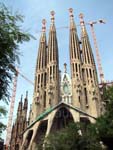
Whether it is a church or not , The Sagrada Família surely is the most exotic church of the world; it is the emblem of the city Barcelona par excellence; With the name Barcelona, most people from all over the world relate the Sagrada Família and the football club 1. F.C. Barcelona. Thus, a visit to the Sagrada Família is an absolute must for all visitors of Barcelona. Finally, such things are not seen every day. Of course, people relate the name Sagrada Família wth the name of the great Catalan master builder Gaudí. In the year 1883, Gaudí took over the leadership of the church construction and remaind active in this huge project until his death in the year 1926. He spent the last 12 years of his life exclusively working for the construction of the emblem of Barcelona. In the first instance, Gaudí was inspired by the nature. This is recognizable, for example, in the shape of the columns in the interior of the church: as a tree, they have a thick trunk that further above branches out in thick branches that sustain the treetop. 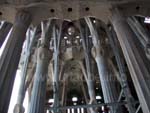
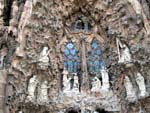
Originally, Gaudí wanted to finish the construction of the Sagrada Família within 15 years. But even up to his death 40 years later, only some parts of the atonement temple were finished. Since then, the further construction of the church was financed with donations and entrance fees (here, at least one knows for what the entrance fee of 6 € is used). But Gaudí did not construct strictly according to the plan and specifications. He was permanently inspired by the nature and continuously changed his building plans. Thus it happened that after his death, there were no appreciable plans for the finalization of the church available, so that today one wonders if the current arquitectural approaches are according to the ideas of Gaudí. For 6 € entrance fee, one can access the complex of the Sagrada Família. I talk about a complex because at ground level, there is a huge building site. This sounds deterrent at first, but it is interesting for the visitor because he can witness from very close how the church is built. It is possible to watch the handicraftsman straight at their work. But what most impressed me where the mosaic builders, as they unhurriedly put one tiny and coloured stone beside the next one and after finishing their working day, they have probably done a tiny partial window of a glass front. 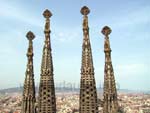
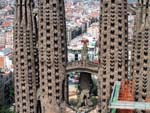
Before getting into the interior of the church one should unhurriedly look at the fronts of the portal into detail. It is simply incredible how the fronts are adorned and squiggled into detail; one can really appraise the amount of work and also learn to understand why it often took centuries to finish the construction of the famous cathedrals. One gets to the highlight - in the truest sense of the word - by ascending the towers. Some small and narrow corkscrew stairs lead through the interior of the towers upwards and over the bridges one gets to the neighboured towers. The view is phenomenal, the view to the towers at the front and the church thereunder also is. With a temperature of more than 30 °C and a high air humidity, it is also not a shame for young people to take the lift instead of ascending the 400 stone stairs. For 1,50 €, one saves a lot of perspiration and power for the rest of the day. The Cathedral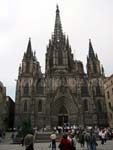
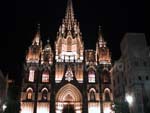
The cathedral of Barcelona is a must for all visitors of Barcelona. It is located at the highest level of the oldtown (only 12 m over the sealevel) and practically forms the centre of the oldtown. The view of the gorgeous god house from the Placa de la Seu is imposing, either by day or by night time. The 11th century began with the construction of the cathedral. Before that, at this place an old basilica stood that was destroyed by the moors. The construction last up to the middle of the 15th century; the main front that is visible today was even not added until the last century. 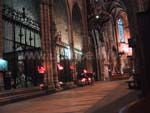
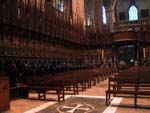
In the interior of the cathedral (the entrance is free of charge) one is first impressed by the massive dimensions of the church: the massive godhouse measures 83 m in length and is of 25 m height. There are three aisles in the cathedral; in the middle of the main aisle, there are the wonderful choir stalls, that are typical for Spanish churches; At the edge of the aisles there is one small chapel after the next; somehow each one tries to beat the neighboured one in beauty and adorments. 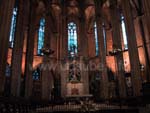
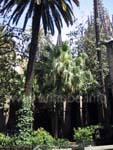
The interior of the cathedral is really impressive, either in size as also in beauty. But the cathedral of Barcelona offers more: right beside it there is the cross-coat with a wonderful small garden and a gothic fountain. Of course, the tourists push here as they would do it only in fun parks or in the Oktoberfest. But what are the geese doing amidst the garden? In medieval times, the geese guarded the cathedral and its at treasures. The gaggling and skirling of the geese would have betrayed each intruser at night. This tradition still exists today, so that one should not be surprised about the geese in the interior of the cross-coat palm garden. Santa María del MarCan a church actually be described as beautiful? Does a beautiful church have to show off gold and glory in all ends , must each column or wood truss be adorned, does each small window be arranged with a laborious glass painting, thus for example as the cathedral of Barcelona? The church Santa María del Mar does not have all this.It attracts by its simplicity, but still transmits an impression of beauty and well being. 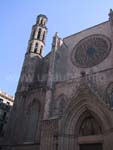
While one probably feels uncomfortable in highly adorned and decorated churches because one is much too distracted by the pomposity and the ostentation, in the church Santa María del Mar one finds some calmness for devotion and meditation. The church was built between 1329 and 1384. For the standards of the medieval times, 55 years building time for a church of this dimension is very sparse; but by abstaining from laborious paintings and outstanding artworks, the finalization of the church took place in such a short time. Moreover, the three aisled gothic building has no cross building. 
In the width of the church the glas windows are the only thing that provide some colours and art in the simplicity of the church. The most impressive and outstanding is the huge window rose over the main portal. Through this big and round glass window, a lot of light comes into the church; beside this, the interior of the church is rather dark. The church Santa María del Mar is located at the southeastern part of the oldtown district. From the subway station Jaume I or form the Picasso-museum, one gets there in a few minutes. The entrance to the church is free of charge, a visit is worthwhile in any case. Sagrat Cor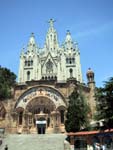
A church that one surely sees without visiting it is the Sagrat Cor. It is located on the Tibidabo in a height of more than 500 m and the Christ monument looks from this proud height down to the city Barcelona. At night, the church is wonderfully illuminated and is very nice to look at, specially from the beach. 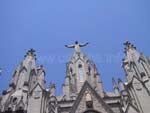
Those who can spend more time in Barcelona should in any case visit the Tibidabo and the church Sagrat Cor. The Sacred-Heart-Church on the Tibidabo was not finished until the year 1961; in principle two churches were built on top of each other: Over the church room in the first floor there is the round basilica. The entrance into the "two" churches is free; the visit does not take too long, since much more spectacular than the church itself is the view from the top of it. One gets to an observation deck at a height of more than 540 m by taking a lift that is subject to a charge. From this observation deck, there are some stairs that lead up to the bottom of the Christ monument. From here, one has a phantastic and unforgettable all-round panorama view down to Barcelona and by looking up, one sees the mountaneous hinterland of the city. 
Copyright: Patrick Wagner, www.tourist-guide.biz |
||